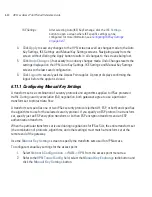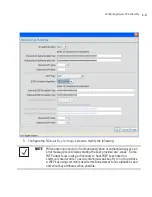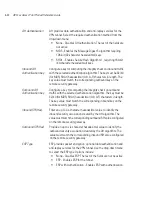
Configuring Access Point Security
6-33
4.
Click
Apply
to save any changes to the Subnet Access screen. Navigating away from the
screen without clicking the Apply button results in all changes to the screens being lost.
5.
Click
Undo Changes
(if necessary) to undo any changes made. Undo Changes reverts the
settings displayed on the Subnet Access screen to the last saved configuration.
6.
Click
Logout
to securely exit the Access Point applet. A prompt displays confirming the
logout before the applet is closed.
6.10.1.1 Available Protocols
Protocols that are not pre-configured can be specified using the drop down list within the
Transport
column within the Subnet Access and Advanced Subnet Access screens. They include:
•
ALL
- Enables all of the protocol options displayed in the drop-down menu (as described
below).
•
TCP
-
Transmission Control Protocol
is
a set of rules for sending data as message units over
the Internet. TCP manages individual data packets. Messages are divided into packets for
efficient routing through the Internet.
•
UDP
-
User Datagram Protocol
is used for broadcasting data over the Internet. Like TCP, UDP
runs on top of Internet Protocol (IP) networks. Unlike TCP/IP, UDP/IP provides few error
recovery services. UDP offers a way to directly connect, and then send and receive
datagrams over an IP network.
•
ICMP
-
Internet Control Message Protocol
is tightly integrated with IP. ICMP messages are
used for out-of-band messages related to network operation. ICMP packet delivery is
unreliable. Hosts cannot count on receiving ICMP packets for a network problem.
•
AH
- Authentication Header is one of the two key components of IP Security Protocol (IPsec).
The other key component is
Encapsulating Security Protocol (ESP)
.
AH provides authentication, proving the packet sender really is the sender, and the data
really is the data sent. AH can be used in transport mode, providing security between two
end points. Also, AH can be used in tunnel mode, providing security like that of a Virtual
Private Network (VPN).
•
ESP
-
Encapsulating Security Protocol
is one of two key components of IP Security Protocol
(IPsec). The other key component is Authentication Header (AH). ESP encrypts the packets
and provides authentication services. ESP can be used in transport mode, providing security
End Port
Enter the ending port number for a port range. If the protocol uses
a single port, leave the field blank. A new entry might use
Web
Traffic
for its name,
TCP
for its protocol, and
80
for its port number.
Summary of Contents for AP 5131 - Wireless Access Point
Page 1: ...AP 51xx Access Point Product Reference Guide ...
Page 3: ...AP 51xx Access Point Product Reference Guide 72E 103901 01 January 2008 ...
Page 4: ......
Page 44: ...AP 51xx Access Point Product Reference Guide 1 28 ...
Page 76: ...AP 51xx Access Point Product Reference Guide 2 32 ...
Page 92: ...AP 51xx Access Point Product Reference Guide 3 16 ...
Page 588: ...AP 51xx Access Point Product Reference Guide 8 254 ...
Page 610: ...AP 51xx Access Point Product Reference Guide 9 22 3 Define a mesh supported WLAN ...
Page 623: ...Configuring Mesh Networking 9 35 3 Determine the Radio MAC Address and BSSID MAC Addresses ...
Page 653: ...Adaptive AP 10 25 line con 0 line vty 0 24 end ...
Page 654: ...AP 51xx Access Point Product Reference Guide 10 26 ...
Page 666: ...AP 51xx Access Point Product Reference Guide A 12 ...
Page 690: ...AP 51xx Access Point Product Reference Guide C 4 ...
Page 696: ...AP 51xx Access Point Product Reference Guide IN 10 ...
Page 697: ......
















































